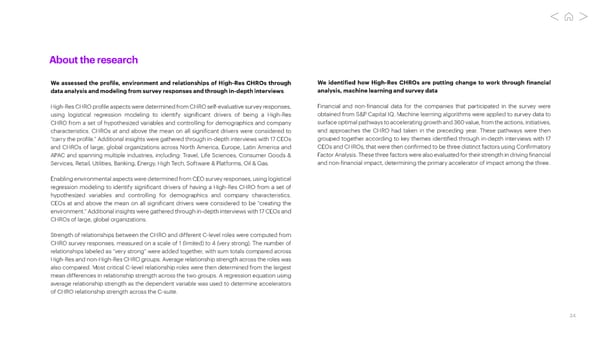About the research We assessed the profile, environment and relationships of High-Res CHROs through We identified how High-Res CHROs are putting change to work through financial data analysis and modeling from survey responses and through in-depth interviews analysis, machine learning and survey data High-Res CHRO profile aspects were determined from CHRO self-evaluative survey responses, Financial and non-financial data for the companies that participated in the survey were using logistical regression modeling to identify significant drivers of being a High-Res obtained from S&P Capital IQ. Machine learning algorithms were applied to survey data to CHRO from a set of hypothesized variables and controlling for demographics and company surface optimal pathways to accelerating growth and 360 value, from the actions, initiatives, characteristics. CHROs at and above the mean on all significant drivers were considered to and approaches the CHRO had taken in the preceding year. These pathways were then “carry the profile.” Additional insights were gathered through in-depth interviews with 17 CEOs grouped together according to key themes identified through in-depth interviews with 17 and CHROs of large, global organizations across North America, Europe, Latin America and CEOs and CHROs, that were then confirmed to be three distinct factors using Confirmatory APAC and spanning multiple industries, including: Travel, Life Sciences, Consumer Goods & Factor Analysis. These three factors were also evaluated for their strength in driving financial Services, Retail, Utilities, Banking, Energy, High Tech, Software & Platforms, Oil & Gas. and non-financial impact, determining the primary accelerator of impact among the three. Enabling environmental aspects were determined from CEO survey responses, using logistical regression modeling to identify significant drivers of having a High-Res CHRO from a set of hypothesized variables and controlling for demographics and company characteristics. CEOs at and above the mean on all significant drivers were considered to be “creating the environment.” Additional insights were gathered through in-depth interviews with 17 CEOs and CHROs of large, global organizations. Strength of relationships between the CHRO and different C-level roles were computed from CHRO survey responses, measured on a scale of 1 (limited) to 4 (very strong). The number of relationships labeled as “very strong” were added together, with sum totals compared across High-Res and non-High-Res CHRO groups. Average relationship strength across the roles was also compared. Most critical C-level relationship roles were then determined from the largest mean differences in relationship strength across the two groups. A regression equation using average relationship strength as the dependent variable was used to determine accelerators of CHRO relationship strength across the C-suite. 34
 The Journey to Operations Maturity | Accenture Page 33 Page 35
The Journey to Operations Maturity | Accenture Page 33 Page 35